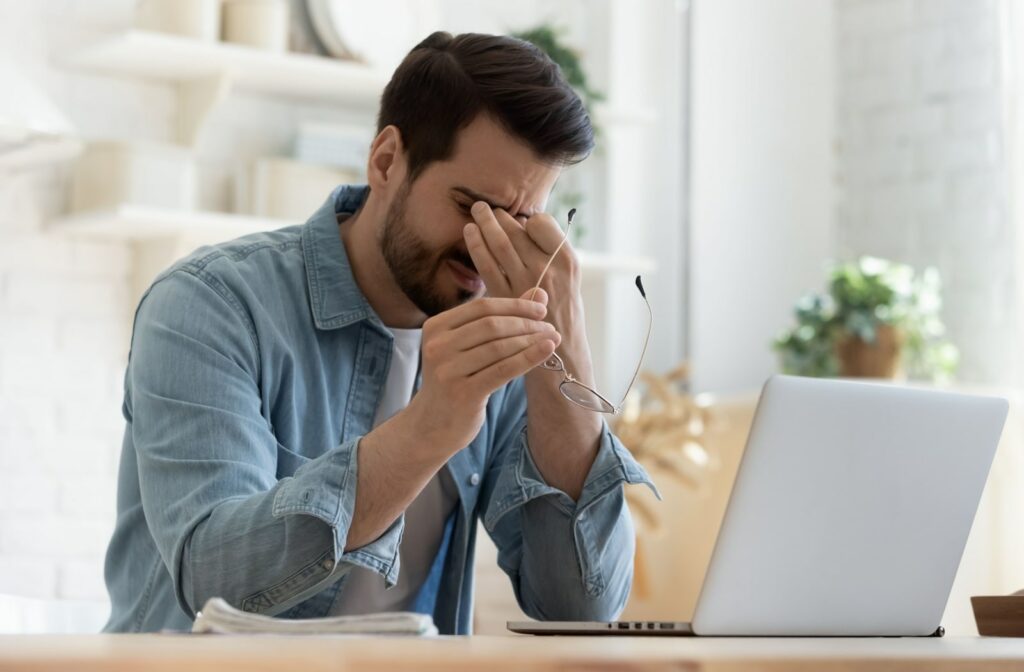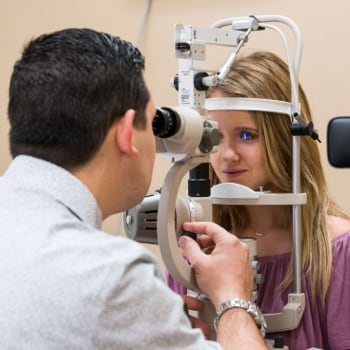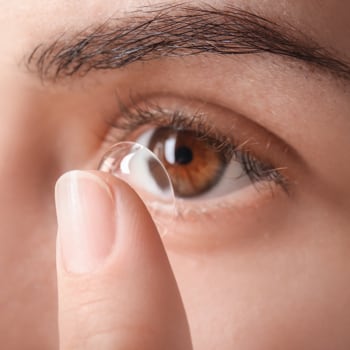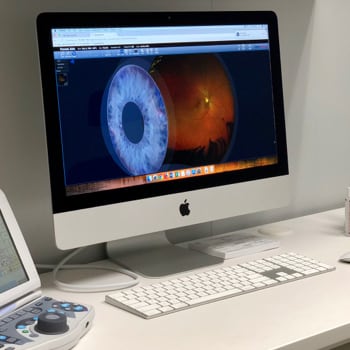If you’ve ever spent hours staring at screens before noticing sore, heavy, and exhausted sensations in your eyes, you were likely dealing with digital eye strain. This common condition can cause all kinds of symptoms ranging from headaches to vision troubles, and it’s something that you should try to prevent whenever possible. But how long can digital eye strain last—and what can you do about it?
Usually, eye strain can last for several hours and resolves on its own. If you start to notice sore, irritated eyes, try to take a break from screens for a while—this should help reduce the symptoms quickly. If your symptoms last more than 24 hours, visit your optometrist to find out if you’re experiencing something else.
What Is Digital Eye Strain?
Your visual system is a lot more complicated than you might think. To focus on something intensely, your eyes need to coordinate tiny muscles to work together properly. But when you’re staring at something nearby for a long time—like a screen—these muscles quickly start to tire out.
Think of any time you’ve tried to hold a weight or carry a heavy bag of groceries for too long. You’ll quickly start noticing burning sensations, almost as if your arms are heavier than normal. It’s a sign that your muscles are exhausted and in desperate need of a break.
The human eye works similarly. When you intensely stare at something, those muscles are overworked, leading to feelings of heaviness and soreness. This is called digital eye strain because it often happens when you’re using digital devices. While this common condition is temporary, it’s still irritating!
Recognizing the Signs of Digital Eye Strain
So how can you tell if you’re dealing with eye strain? Try to keep an eye out for signs of discomfort whenever you’re spending too long using screens. Whether you’re typing away for work, playing a video game, or watching TV, look out for:
- Tired, heavy eyes
- Overall fatigue
- Headaches
- Blurry vision
- Neck and shoulder pain
- Increased light sensitivity
- Difficulty concentrating
If you notice any of these symptoms, you’re likely experiencing digital eye strain. Typically, these will go away on their own—likely within a few hours.
Taking a break from your screen is the quickest measure to reduce these symptoms. However, if you notice that your symptoms are sticking around, visit your optometrist as soon as you can to rule out other potential problems.
What Causes Digital Eye Strain?
The initial cause of eye strain is those tiny muscles tiring out. They’re overworked and need a break, and they’ll quickly start to feel heavier and sore when they’re starting to exhaust themselves. However, that’s not the only factor at play.
Whenever you’re focusing on your screen, you’re likely blinking less than you should. Usually, you blink around 15-18 times a minute or so, but when you’re trying to pay attention to the tiny details on a screen, this drops by more than 60%. While it’s a natural response, it can often make symptoms of digital eye strain more severe.
This is due to how it leaves your eye unprotected. When you blink, you’re dispersing a thin film of tears across the eye’s surface, helping keep it hydrated and protected from the outside air. But when you blink less, the eye isn’t properly covered; this can quickly lead to further discomfort.
Other Causes of Eye Strain
Your physical environment plays a role as well. Eye strain becomes worse due to the following:
- Poor lighting
- Glare
- Poor screen position
- Poor posture
- Incorrect contrast and brightness settings
With eye strain, prevention is key. So how do you do it?
How to Reduce Eye Strain
Knowing what causes eye strain is half of the battle. It lets you know what to plan for when trying to prevent these symptoms from developing in the first place.
Here are some tips to prevent eye strain:
- Take regular breaks when you’re at your desk
- Follow the 20-20-20 rule. Every 20 minutes, take a 20-second break and focus on something 20 feet away. This helps re-orient your eyes and gives them a break from focusing at a set distance.
- Make sure your workspace is well-lit
- Try to make a conscious effort to blink more often
- Set your screen a little lower than eye level, and at around arm’s length
- Practice good posture
- Adjust your brightness and contrast settings so they’re more comfortable
If you do all of this and still notice eye strain, visit your optometrist to discuss solutions. They may be able to recommend alternative ways to prevent eye strain in the future.
When to See Your Optometrist About Eye Strain
At Great Hills Eye Care, we know how important it is to have clear and comfortable vision. Our team is here to help you prevent those feelings of discomfort, and we’re ready to help you take charge of your eye health. Book an appointment today, and let’s work together to prevent digital eye strain!














